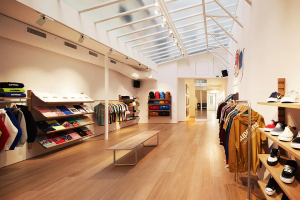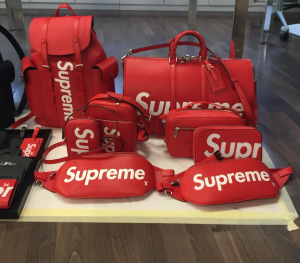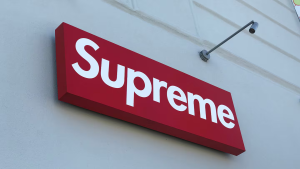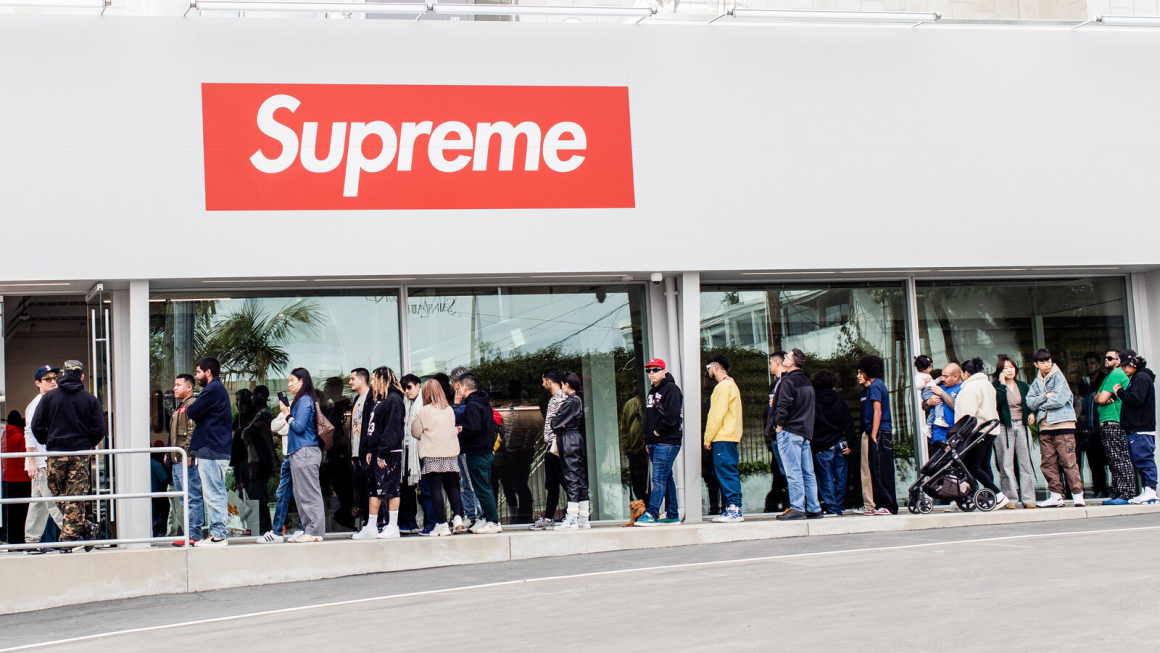In the crowded landscape of streetwear brands, one red box logo reigns supreme — literally.
What began in 1994 as a modest skate shop on Lafayette Street in downtown Manhattan has transformed into perhaps the most influential fashion phenomenon of the 21st century. Supreme isn’t just a clothing brand; it’s a cultural institution that has fundamentally altered how products are released, marketed, and valued in the modern fashion ecosystem.
But what exactly makes Supreme so, well, supreme?
Let’s unpack the genius behind the brand that turned scarcity into desire and streetwear into high fashion.
The Drop Model: Turning Thursdays into Fashion Holidays

If you’ve ever witnessed the ritual of a Supreme drop—either by joining the blocks-long lines outside one of their stores or frantically refreshing your browser at 10:59 AM on a Thursday—you’ve experienced firsthand the revolutionary retail model that changed fashion forever.
Unlike traditional fashion brands that release seasonal collections all at once, Supreme pioneered what we now know as the “drop” system: releasing small batches of products weekly throughout the season. Each Thursday at 11 AM, a new selection of items becomes available online and in stores. By 11:01 AM, the most coveted pieces are already sold out.
This calculated scarcity is no accident. Supreme intentionally produces fewer items than they could sell—sometimes drastically fewer. The result? A perpetual state of demand that exceeds supply, creating a marketplace where Supreme’s products are valued not just for their design or quality, but for their rarity.
“If you have 10 items and you make 1,000 of each, you might sell 600 and have 400 left on the racks,” explained James Jebbia, Supreme’s founder, in a rare 2009 interview with Interview Magazine.
“But if you have 10 items and make 100 of each, and you sell out, you’ve made far less money than the guy who sold 600, but you have a much stronger business.”
This approach flipped traditional retail wisdom on its head. While most brands measure success by how much they sell, Supreme measures success by how quickly they sell out. The formula has worked spectacularly—building not just a clothing line but a global community of devotees who treat each Thursday drop with religious fervor.
The impact of this model extends far beyond Supreme itself. Countless brands across fashion, footwear, and even luxury houses have adopted similar drop strategies, creating a new normal where limited availability isn’t just a supply chain issue—it’s a marketing strategy.
When Street Met Luxury: The Louis Vuitton Collaboration That Changed Everything

If Supreme’s drop model was revolutionary, their 2017 collaboration with Louis Vuitton was nothing short of industry-shattering. The partnership between a skate shop and a 163-year-old French luxury house represented the ultimate validation of streetwear as a legitimate fashion force.
The irony wasn’t lost on industry insiders. Just 17 years earlier, Louis Vuitton had sent Supreme a cease-and-desist letter for using an unauthorized version of their monogram pattern on skateboards. Now, the two brands were willingly merging their logos in what would become one of fashion’s most lucrative partnerships.
When the collection debuted at Paris Men’s Fashion Week in January 2017, it created immediate pandemonium. The items—which included everything from $65,000 trunks to $855 hoodies—sold out instantly when they hit stores in June, with pieces immediately commanding multiples of their retail prices on the secondary market.
The financial impact was substantial for both brands. LVMH reported that the collaboration was a “highlight” in its 2017 financial results, contributing to a 23% profit increase for the first half of the year. For Supreme, the collaboration elevated the brand to new heights of global recognition and cemented its place as a legitimate fashion force—not just a niche streetwear label.
But the true significance of the collaboration went beyond sales figures. It marked the moment when the distinction between “high” and “low” fashion effectively collapsed.
As Kim Jones, then Louis Vuitton’s men’s artistic director, explained:
“You can’t have the conversation of New York men’s wear without having Supreme in it.”
The partnership created a template for how luxury brands could tap into youth culture without sacrificing their prestige positioning—a blueprint that countless other luxury houses have since followed.
From Dior x Air Jordan to Gucci x The North Face, the high-low collaboration has become a standard feature of the luxury landscape, with Supreme’s Louis Vuitton partnership serving as the urtext.
Trophy Pieces: The Supreme Items That Became Investment Assets
Supreme’s limited availability and cultural cachet have created a robust secondary
market where certain pieces command astronomical prices. Here are some of the
most valuable Supreme items ever released and the stories behind their eyepopping valuations:
Supreme x Louis Vuitton Trunk ($125,000)
The undisputed king of Supreme collectibles, this trunk from the 2017 Louis Vuitton collaboration originally retailed for around $68,500.
Combining Louis Vuitton’s legendary craftsmanship with Supreme’s red logo, only a handful were produced. One sold at auction for $125,000 in 2019, making it the most expensive Supreme item ever sold.
Its value stems not just from its rarity but from its status as the ultimate symbol of the high-fashion/streetwear fusion that has come to define contemporary style.
Supreme x Louis Vuitton Malle Courrier 90 Trunk ($100,000+)
Another piece from the landmark 2017 collaboration, this trunk features the Louis Vuitton monogram pattern in Supreme’s signature red and white colors.
Originally retailing for around $57,000, these trunks regularly sell for six figures on the secondary market.
Their value reflects both their extreme scarcity and their perfect encapsulation of a watershed moment in fashion history.
Supreme Pinball Machine ($125,000)
In 2018, Supreme released a custom Stern pinball machine as part of their accessories line.
Priced at $11,500 retail, only an estimated 8–10 machines were produced, making it one of the rarest Supreme items ever.
The combination of extreme scarcity, functional art, and the sheer audacity of a skateboard brand producing a pinball machine has driven prices to astronomical heights.
Supreme x Damien Hirst Box Logo T-shirt ($50,000+)
Released in 2009, this collaboration with controversial British artist Damien Hirst featured Hirst’s signature dot pattern on Supreme’s box logo.
Part of a charitable release supporting AIDS awareness, the shirt has become legendary for its perfect combination of art world credibility, streetwear cool, and extreme rarity.
While original retail was just $48, these shirts now sell for tens of thousands when they surface.
Supreme “Sample” Box Logo Hoodie ($25,000+)
In the world of Supreme collecting, production samples represent the ultimate grail items.
These test pieces, never intended for public release, occasionally make their way to the market through factory leaks or employee connections.
The most coveted are sample colorways of the iconic box logo hoodie that never saw official production.
Their five-figure prices reflect not just their one-of-one status but the insider cachet they carry among serious collectors.
Supreme x Nike SB Dunk Low “Paris” ($175,000+)
While technically a Nike release featuring Supreme’s involvement, this 2003 sneaker collaboration has reached mythic status among collectors.
Each pair featured unique panels cut from Bernard Buffet artworks, making every one of the 202 pairs produced completely unique.
A pair sold at Sotheby’s in 2021 for $176,400, making them among the most expensive sneakers ever sold at auction.
What unites these astronomical valuations is Supreme’s mastery of the intangible.
The brand has perfected the art of creating not just products but artifacts—physical embodiments of cultural moments that transcend their material value.
When someone pays six figures for a Supreme trunk or pinball machine, they’re not just buying an object; they’re buying a piece of fashion history.
The Legacy: How Supreme Changed Fashion Forever

Nearly three decades after its founding, Supreme’s influence extends far beyond its own products. The brand has fundamentally transformed how fashion brands approach everything from product releases to marketing to retail experiences:
-
The drop model has been adopted by countless brands—from fast fashion retailers to luxury houses—creating a culture of limited releases and artificial scarcity that dominates contemporary retail.
-
The collaboration playbook that Supreme perfected is now standard practice across the industry, with unexpected partnerships becoming an expected part of brand strategy.
-
The resale economy that Supreme helped create has evolved into a multibillion-dollar industry, with platforms like StockX and GOAT built largely around facilitating the secondary market for limited-release products.
-
The merging of streetwear and luxury that Supreme catalyzed has transformed high fashion, with streetwear aesthetics and casual silhouettes now dominating runway shows from Paris to Milan.
-
The elevation of logo as luxury that Supreme exemplified has changed how consumers think about branding, with visible logos returning to prominence after years of minimalism.
In 2020, VF Corporation acquired Supreme for $2.1 billion—a stunning valuation for a brand that began as a single skate shop.
The acquisition represented the ultimate mainstreaming of what had once been a countercultural force.
For longtime Supreme devotees, the corporate acquisition might have seemed like the end of an era. But in many ways, it was the logical conclusion to Supreme’s journey:
From outsider to insider, from subculture to pop culture, from skate shop to global phenomenon.
The true genius of Supreme isn’t just that they created coveted products—
They created a template for how modern brands are built, marketed, and consumed.
That red box logo isn’t just a symbol of a clothing company—
It’s the emblem of an approach to fashion and culture that has reshaped the entire industry.
In a world of constant reinvention and endless hype cycles, Supreme’s greatest achievement might be that they’ve never had to reinvent themselves.
By staying true to their core identity while mastering the art of cultural relevance, they’ve built something truly rare in fashion:
A timeless brand built on ephemeral drops.
Now that’s supreme.

